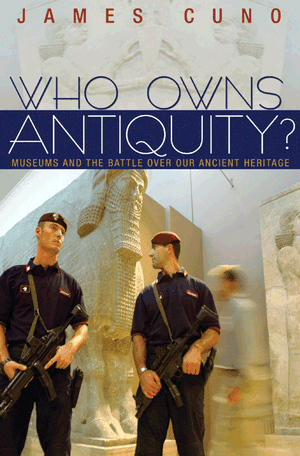
Who Owns Antiquity?: Museums and the Battle over Our Ancient Heritage
by James Cuno
That Muqtada Al-Sadr once controlled the Iraq National Museum does a lot to credit James Cuno’s argument against considering antiquities as property of particular countries.
The radical cleric was charged with the museum’s protection after the coalition-appointed museum director, Donny George, fled the country, and after the museum came under attack during the American assault. But rather than protect the museum, one of the most prestigious collections in the Middle East, Al-Sadr allegedly allowed looting from the museum and illegal trafficking of its antiquities to continue, as it had during the American invasion.
It was an unfortunate circumstance that demonstrated the difficulty of preserving a country’s heritage in times of conflict. But even in peacetime, Cuno argues, countries cannot be counted on to properly preserve their antiquities, and in fact, may simply be the wrong vehicle for doing so. His case – and the broad strokes of his reasoning, drawing on international law, political philosophy, and archaeology – is an important one to bear in mind in a time when more and more countries demand the return of, and make it illegal to acquire, stolen antiquities, even as the market for them continues to thrive.
Cuno, director of the Art Institute of Chicago, once responded to the question of whether he would condone acquiring illegally exported antiquities with an unambiguous no. His answer is still no, he writes, “But now the question [is] more complex.” Who Owns Antiquities? elaborates on the questions, pursuing them forcefully and confidently: how much information about the object’s past is available, how well the country preserves its antiquities, what American and international laws govern the issue, and, more profoundly, “What is the relationship between antiquities and cultural property?…Is it really a scientific question or a political one?”
When countries request the return of antiquities, and when other countries comply, the process is almost entirely political, Cuno asserts. Even international agreements that have arisen to regulate such negotiations don’t work, he argues, because such agreements are no more than the sum of their signatories. That is, countries can refuse to ratify conventions, and even when they do ratify them, they can ignore them. The U.S. held out from UNESCO for 13 years, and withdrew after it signed only to rejoin again in spring 2003, corresponding with the start of the Iraq war. UNESCO, Cuno writes, “unambiguously respects the nation-state and vests authority in it.” For that reason, “it has no teeth.” While some countries comply with retentionist laws, others don’t. And even if everyone did, Cuno argues, that’s no reason to imagine that the market for stolen art would die.
Complicating the matter further, Cuno notes, is that countries are, ultimately, constructions. They don’t correspond to ancient civilizations geographically, demographically, or culturally; what aspects of their culture they choose to bolster depends on politics. Cuno profiles the cases of China and Turkey. Turkey’s people can claim that they once lived in lands now part of Russia and China, but they are also Ottoman and Anatolian, secular and Islamic. Its ruling authorities can enfranchise certain historical legacies over others, and can suppress some (like that of the Kurdish people) entirely. China has expanded to include regions its former dynasties controlled only nominally or not at all, including regions like Xinjiang, with a culture and archaeology more closely linked to Central Asia or South Asia. The Chinese government prohibits foreign nationals from acquiring unprovenanced art (art without a known past, likely to have been stolen) but allows its own citizens to do exactly that.
Other countries are no different. Cuno notes that Italy seeks to reclaim antiquities discovered throughout its former empire, far outside its current boundaries, even though its museums are engorged with artifacts. And Iraq has been Babylonian and Arab, and is home to the stateless Kurds; its rulers draw on various strains of that cultural heritage while suppressing others, determining which antiquities are preserved and which languish. It was under British rule when the Iraqi museum was established, suggesting that a country can shore up its own cultural preservation while still allowing foreigners to export objects.
This principle of sharing, or “partage,” is Cuno’s preferred method of managing antiquities, allowing for the preservation of a cultural heritage within a country, but also within foreign museums that aspire to be “encyclopedic,” to contextualize antiquities not simply within one culture, civilization, or country, but rather, within the full legacy of humankind.
Excerpt: “Works of art are made from encounters with new and startling things, and they encourage us to see further associations and to explore their implications. That is the nature of culture. And this is what encyclopedic museums can offer that no other kind of institution can: they reveal the truth about our nature as curious, sentient beings alive to the world of differences and similarities. Ours is a contaminated world of mongrel races.”
Further Reading: Whose Muse?: Art Museums and the Public Trust and Loot: The Battle over the Stolen Treasures of the Ancient World




Send A Letter To the Editors